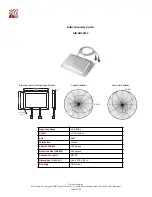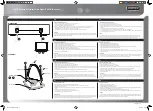
Cisco Systems, Inc.
All contents are Copyright © 2003 Cisco Systems, Inc. All rights reserved. Important Notices and Privacy Statement.
Page 5 of 29
Multipath Distortion
Multipath interference occurs when an RF signal has more than one path between a receiver and a transmitter. This occurs in sites
that have a large amount of metallic or other RF reflective surfaces.
Just as light and sound bounce off of objects, so does RF. This means there can be more than one path that RF takes when going
from a TX to and RX antenna. These multiple signals combine in the RX antenna and receiver to cause distortion of the signal.
Multipath interference can cause the RF energy of an antenna to be very high, but the data would be unrecoverable. Changing the
type of antenna, and location of the antenna can eliminate multipath interference.
Figure 4
Multipath Distortion
You can relate this to a common occurrence in your car. As you pull up to a stop, you may notice static on the radio. But as you
move forward a few inches or feet, the station starts to come in more clearly. By rolling forward, you move the antenna slightly, out
of the point where the multiple signals converge.
A diversity antenna system can be compared to a switch that selects one antenna or another, never both at the same time. The radio
in receive mode will continually switch between antennas listening for a valid radio packet. After the beginning sync of a valid
packet is heard, the radio will evaluate the sync signal of the packet, on one antenna, then switch to the other antenna and evaluate.
Then the radio will select the best antenna, and use only that antenna for the remaining portion of that packet.
On transmit, the radio will select the same antenna it used the last time it communicated to that given radio. If a packet fails, it will
switch to the other antenna and retry the packet.
One caution with diversity, it is not designed for using two antennas, covering two different coverage cells. The problem in using it
this way, is that if antenna #1 is communicating to device #1, while device #2 (which is in the antenna #2 cell) tries to communicate,
antenna #2 is not connected (due to the position of the switch), and the communication fails. Diversity antennas should cover the
same area, from only a slightly different location.
With the introduction of the latest DS physical layer chips, and the use of diversity antenna systems, DS systems have equaled or
surpassed FH in areas of how Multipath interference is handled. While the introduction of WBFH does increase the bandwidth of
the FH systems, it drastically effects the ability to handle multipath issues, further reducing its range compared to present DS systems
in high RF reflective sites.
Ceiling
Time
Combined Results
Received Signals
Floor
TX
RX
Obstruction
Time





































